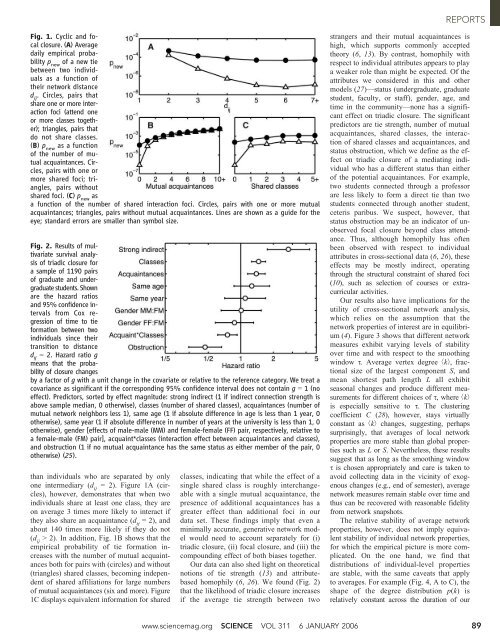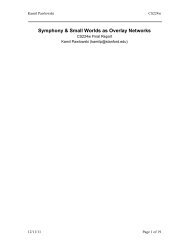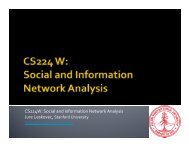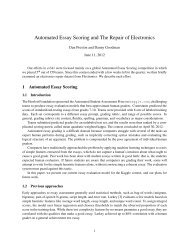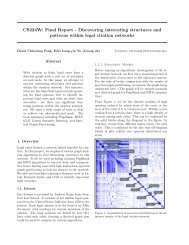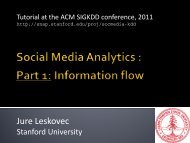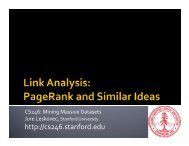Empirical Analysis of an Evolving Social Network - Science
Empirical Analysis of an Evolving Social Network - Science
Empirical Analysis of an Evolving Social Network - Science
You also want an ePaper? Increase the reach of your titles
YUMPU automatically turns print PDFs into web optimized ePapers that Google loves.
Fig. 1. Cyclic <strong>an</strong>d focal<br />
closure. (A) Average<br />
daily empirical probability<br />
p new <strong>of</strong> a new tie<br />
between two individuals<br />
as a function <strong>of</strong><br />
their network dist<strong>an</strong>ce<br />
d ij .Circles,pairsthat<br />
share one or more interaction<br />
foci (attend one<br />
or more classes together);<br />
tri<strong>an</strong>gles, pairs that<br />
do not share classes.<br />
(B) p new as a function<br />
<strong>of</strong> the number <strong>of</strong> mutual<br />
acquaint<strong>an</strong>ces. Circles,<br />
pairs with one or<br />
more shared foci; tri<strong>an</strong>gles,<br />
pairs without<br />
shared foci. (C) p new as<br />
a function <strong>of</strong> the number <strong>of</strong> shared interaction foci. Circles, pairs with one or more mutual<br />
acquaint<strong>an</strong>ces; tri<strong>an</strong>gles, pairs without mutual acquaint<strong>an</strong>ces. Lines are shown as a guide for the<br />
eye; st<strong>an</strong>dard errors are smaller th<strong>an</strong> symbol size.<br />
Fig. 2. Results <strong>of</strong> multivariate<br />
survival <strong>an</strong>alysis<br />
<strong>of</strong> triadic closure for<br />
asample<strong>of</strong>1190pairs<br />
<strong>of</strong> graduate <strong>an</strong>d undergraduate<br />
students. Shown<br />
are the hazard ratios<br />
<strong>an</strong>d 95% confidence intervals<br />
from Cox regression<br />
<strong>of</strong> time to tie<br />
formation between two<br />
individuals since their<br />
tr<strong>an</strong>sition to dist<strong>an</strong>ce<br />
d ij 0 2. Hazard ratio g<br />
me<strong>an</strong>s that the probability<br />
<strong>of</strong> closure ch<strong>an</strong>ges<br />
by a factor <strong>of</strong> g with a unit ch<strong>an</strong>ge in the covariate or relative to the reference category. We treat a<br />
covari<strong>an</strong>ce as signific<strong>an</strong>t if the corresponding 95% confidence interval does not contain g 0 1 (no<br />
effect). Predictors, sorted by effect magnitude: strong indirect (1 if indirect connection strength is<br />
above sample medi<strong>an</strong>, 0 otherwise), classes (number <strong>of</strong> shared classes), acquaint<strong>an</strong>ces (number <strong>of</strong><br />
mutual network neighbors less 1), same age (1 if absolute difference in age is less th<strong>an</strong> 1 year, 0<br />
otherwise), same year (1 if absolute difference in number <strong>of</strong> years at the university is less th<strong>an</strong> 1, 0<br />
otherwise), gender [effects <strong>of</strong> male-male (MM) <strong>an</strong>d female-female (FF) pair, respectively, relative to<br />
a female-male (FM) pair], acquaint*classes (interaction effect between acquaint<strong>an</strong>ces <strong>an</strong>d classes),<br />
<strong>an</strong>d obstruction (1 if no mutual acquaint<strong>an</strong>ce has the same status as either member <strong>of</strong> the pair, 0<br />
otherwise) (25).<br />
th<strong>an</strong> individuals who are separated by only<br />
one intermediary (d ij 0 2). Figure 1A (circles),<br />
however, demonstrates that when two<br />
individuals share at least one class, they are<br />
on average 3 times more likely to interact if<br />
they also share <strong>an</strong> acquaint<strong>an</strong>ce (d ij 0 2), <strong>an</strong>d<br />
about 140 times more likely if they do not<br />
(d ij 9 2). In addition, Fig. 1B shows that the<br />
empirical probability <strong>of</strong> tie formation increases<br />
with the number <strong>of</strong> mutual acquaint<strong>an</strong>ces<br />
both for pairs with (circles) <strong>an</strong>d without<br />
(tri<strong>an</strong>gles) shared classes, becoming independent<br />
<strong>of</strong> shared affiliations for large numbers<br />
<strong>of</strong> mutual acquaint<strong>an</strong>ces (six <strong>an</strong>d more). Figure<br />
1C displays equivalent information for shared<br />
classes, indicating that while the effect <strong>of</strong> a<br />
single shared class is roughly interch<strong>an</strong>geable<br />
with a single mutual acquaint<strong>an</strong>ce, the<br />
presence <strong>of</strong> additional acquaint<strong>an</strong>ces has a<br />
greater effect th<strong>an</strong> additional foci in our<br />
data set. These findings imply that even a<br />
minimally accurate, generative network model<br />
would need to account separately for (i)<br />
triadic closure, (ii) focal closure, <strong>an</strong>d (iii) the<br />
compounding effect <strong>of</strong> both biases together.<br />
Our data c<strong>an</strong> also shed light on theoretical<br />
notions <strong>of</strong> tie strength (13) <strong>an</strong>d attributebased<br />
homophily (6, 26). We found (Fig. 2)<br />
that the likelihood <strong>of</strong> triadic closure increases<br />
if the average tie strength between two<br />
REPORTS<br />
str<strong>an</strong>gers <strong>an</strong>d their mutual acquaint<strong>an</strong>ces is<br />
high, which supports commonly accepted<br />
theory (6, 13). By contrast, homophily with<br />
respect to individual attributes appears to play<br />
a weaker role th<strong>an</strong> might be expected. Of the<br />
attributes we considered in this <strong>an</strong>d other<br />
models (27)—status (undergraduate, graduate<br />
student, faculty, or staff), gender, age, <strong>an</strong>d<br />
time in the community—none has a signific<strong>an</strong>t<br />
effect on triadic closure. The signific<strong>an</strong>t<br />
predictors are tie strength, number <strong>of</strong> mutual<br />
acquaint<strong>an</strong>ces, shared classes, the interaction<br />
<strong>of</strong> shared classes <strong>an</strong>d acquaint<strong>an</strong>ces, <strong>an</strong>d<br />
status obstruction, which we define as the effect<br />
on triadic closure <strong>of</strong> a mediating individual<br />
who has a different status th<strong>an</strong> either<br />
<strong>of</strong> the potential acquaint<strong>an</strong>ces. For example,<br />
two students connected through a pr<strong>of</strong>essor<br />
are less likely to form a direct tie th<strong>an</strong> two<br />
students connected through <strong>an</strong>other student,<br />
ceteris paribus. We suspect, however, that<br />
status obstruction may be <strong>an</strong> indicator <strong>of</strong> unobserved<br />
focal closure beyond class attend<strong>an</strong>ce.<br />
Thus, although homophily has <strong>of</strong>ten<br />
been observed with respect to individual<br />
attributes in cross-sectional data (6, 26), these<br />
effects may be mostly indirect, operating<br />
through the structural constraint <strong>of</strong> shared foci<br />
(10), such as selection <strong>of</strong> courses or extracurricular<br />
activities.<br />
Our results also have implications for the<br />
utility <strong>of</strong> cross-sectional network <strong>an</strong>alysis,<br />
which relies on the assumption that the<br />
network properties <strong>of</strong> interest are in equilibrium<br />
(4). Figure 3 shows that different network<br />
measures exhibit varying levels <strong>of</strong> stability<br />
over time <strong>an</strong>d with respect to the smoothing<br />
window t. Average vertex degree bkÀ, fractional<br />
size <strong>of</strong> the largest component S, <strong>an</strong>d<br />
me<strong>an</strong> shortest path length L all exhibit<br />
seasonal ch<strong>an</strong>ges <strong>an</strong>d produce different measurements<br />
for different choices <strong>of</strong> t, wherebkÀ<br />
is especially sensitive to t. The clustering<br />
coefficient C (28), however, stays virtually<br />
const<strong>an</strong>t as bkÀ ch<strong>an</strong>ges, suggesting, perhaps<br />
surprisingly, that averages <strong>of</strong> local network<br />
properties are more stable th<strong>an</strong> global properties<br />
such as L or S. Nevertheless, these results<br />
suggest that as long as the smoothing window<br />
t is chosen appropriately <strong>an</strong>d care is taken to<br />
avoid collecting data in the vicinity <strong>of</strong> exogenous<br />
ch<strong>an</strong>ges (e.g., end <strong>of</strong> semester), average<br />
network measures remain stable over time <strong>an</strong>d<br />
thus c<strong>an</strong> be recovered with reasonable fidelity<br />
from network snapshots.<br />
The relative stability <strong>of</strong> average network<br />
properties, however, does not imply equivalent<br />
stability <strong>of</strong> individual network properties,<br />
for which the empirical picture is more complicated.<br />
On the one h<strong>an</strong>d, we find that<br />
distributions <strong>of</strong> individual-level properties<br />
are stable, with the same caveats that apply<br />
to averages. For example (Fig. 4, A to C), the<br />
shape <strong>of</strong> the degree distribution p(k) is<br />
relatively const<strong>an</strong>t across the duration <strong>of</strong> our<br />
www.sciencemag.org SCIENCE VOL 311 6 JANUARY 2006 89


